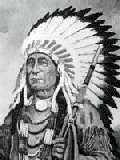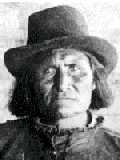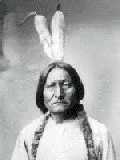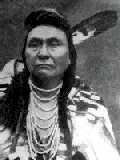Omaha Nation (umaNhaN)
Language
The Omaha nation are from the Dhegiha Siouan language family group, which also includes the Ponca, Quapaw, Osage, and Kansa peoples. Each member's language is slightly different although it is known that the language of the Omaha nation is mutually intelligible with the Ponca, who lived nearby during the early days of Omaha City.**
Omaha/Mahar/Umonhan Nation Name
The tribal name meaning is questionable as there are more than one reference explaining its translation. One reference says that it is derived from a word meaning, "those that go upstream (against the current)." This phase is used to explain that the Maha nation were a clan that separated from a larger nation and then traveled upstream (up the Missouri River) to establish a new home. The place they settled was near the Omaha reservation area way north of present day Omaha. The location was above a stream they named E-ro-ma-ha. Later the pronunciation evolved into Omaha as understood by the early white visitors to the area. The nation itself became known as the Omaha nation.
Howard Wolf,* local Omaha Native American and Omaha Nation historian tells the story that somewhere around 1200 to 1400, natives moved from the Ohio River Valley area to settle nearer to our area. On their journey, they encountered a river that was difficult to cross. One group made it across but the remaining were split, part were trapped on a sandbar and the others were still on the opposite shore. A windstorm came up and blew gray sandy soil all over the heads of the ones trapped on the sandbar. The ones on the opposite shore jokingly called them bha-quda, meaning gray head. Eventually the ones trapped on the sandbar came across. They became known as the Iowa nation. Those on the opposite side floated downstream and became known as the Osage, Kansa, Kaw, and Quapa nations. The first group, referred to the group that made it across, were known as Umaha, which has become to be known to mean "against the stream" due to the Umaha being upstream from the ones that settled further downstream. The word was later misinterpreted by the Europeans as Omaha. It is possible that Lewis and Clark's own interpretation of umaNhaN, spelled out phonetically as Mahar influenced later interpretations of the name to become oo-mah-hah, and later oo-ma-ha.
Another interesting version of how the natives became known as the Omaha nation was retold when Jesse Lowe (Omaha's first mayor) suggested the name for the city of Omaha.
Jesse Lowe, one of the first Council Bluffs businessmen to stake out plots of land in the Omaha area suggested the city be named after the Omaha Nation, and told the story of how they got their name. It was based on a traditional story the Omaha Indians had preserved, in that two nations had met at the Missouri River and engaged in an encounter in which all on one side were killed but one, who had been thrown into the river. Rising suddenly from what was thought to be a watery grave, he lifted his head above the surface and pronounced the word "Omaha,"* which had never been heard before. The meaning was that the supposedly drowning Indian was above the water and not under it as his enemies supposed, and those that heard it took that word as the name of the nation.* This account is reported in The History of Nebraska, Volume I, written in 1882.
Missionaries appeared in the area somewhere in the early 1800s, not long after Lewis and Clark passed through. One reference that comes from the Episcopalian church history lists the name as Omaha in 1836, however, the book was written in 1998 so the name might have been translated to a more common usage than was used in 1836.
Migration
Early on, the Omaha nation were among the North American natives that lived in earth dwellings and sometimes used bark lodges. During times they were on the move, especially during hunting expeditions, they used the four pole tipi (teepees), covered in skins due to its flexibility. The ease in setup-teardown, plus the poles covered with skins could be dragged by dogs (and later horses*) to transport cargo or even the elderly. At the time the early settlers reached the Missouri River, the Omaha natives were observed living in a mixture of teepees (tipi) and mound homes. The mound homes were not a quick build home; they required a two year preparation. The mound is built from a buildup of dirt and prairie grasses or other plants. The floor was made of fired clay in order that it could be cleaned easily by sweeping. Even though there were a lot of similarities, each home was different in how they were decorated or the plants used on the mound. Inside, the homes used a common circular layout. Beds were made between support poles, women to the left of the entrance near where the food was prepared, and the men and boys on the right of the entrance, ready to protect the family from intruders or other dangers.
The Omaha nation migrated several times during the 16th and 17th Centuries, ranging from the Minnesota and Wisconsin area and later on settled near Sioux City, Iowa where the Missouri River and Big Sioux River meet. This is where the Lewis and Clark Expedition met them during 1804. This area was known as Big Village. It was settled around 1790 and the Omaha nation remained in this area for 95 years, abandoning the area around 1845.* In 1802, smallpox nearly decimated many nations including the Omaha nation. Also during the Big Village era, the Omaha nation were in continued conflict with the Sioux nations, causing them to move further south, closer to Omaha.
The Omaha nation lived north of the Platte River in the middle 1800s. Near Omaha, the Platte curves south as it heads to Plattsmouth. In this area was where the majority of the Omaha nation lived when the early settlers started crossing the Missouri by the middle of the 19th century.
The largest gathering of the Omaha nation (approximately 1,300) was situated about three miles west of Bellevue. The leader of the Omaha nation at the time was Big Elk (Ong-pa-ton-ga), who had thrown a block across the Missouri River around the Mormon Bridge area, charging anyone that came upstream or downstream to allow them to pass.
Interaction with settlers
Big Elk was instrumental in making arrangements for the Mormons to stay closer to the Missouri River (than the first encampment they had decided on) when other Indian nations were in disagreement over how much rent should be paid for staying on their lands. Sadly, Big Elk journeyed to the great pow-wow in the sky the same year (1846). He is buried in Bellevue's Pioneer Cemetery. Big Elk was the last full-blooded chief of the Omaha nation.
Following the settling of Omaha City, the Omaha nation were an important part of the early area history. Big Elk's grandson, Logan Fontenelle meshed well with the white settlers and left his own influence on the city of Omaha and nearby communities. As an example, for a period of time during the middle to late 1800s, the town of Fontanelle* was a prominent community on the Elkhorn River.* Fontenelle Boulevard was the trail out of town to same, the fabulous Fontenelle Hotel was the grandeur hotel of its time, and now the Fontenelle Nature Association carries on the tradition of appreciating nature and our environment, all inspired by one man. Although no one knows the exact spot, Logan Fontenelle is buried in Fontenelle Forest.*
Treaty
The treaty of March 16th, 1854 ceded all Omaha native lands to the United States, except for Thurston County in northeast Nebraska. A second treaty of March 6th, 1865 sold the northern part to accommodate the Winnebago Reservation.
Of note
A delegation of the Omaha nation was represented at the 1898 Trans-Mississippi International Exposition and Indian Congress in Omaha.
Currently
The Omaha nation continues to be a strong Native American nation. The community has profited from a casino operated by the nation. Against harsh realities, there is no better example of survivor and no better choice for the name of a great city.
Continue Reading 
- Native Intro
- Native History
- Vásquez de Coronado's Attack on the Natives
- Sacagawea and the Lewis & Clark Expedition
- Native Nations Index
- Native Languages Tree
- Omaha Nation







